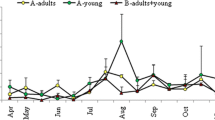Abstract
From March 2001 to February 2004, 724 faecal samples of cattle under field conditions were collected in 121 farms from Lugo (NW Spain), an area with oceanic climate. The risk periods of infection by Paramphistomum trematoda in cattle was assessed by analyzing the prevalence of paramphistomosis, egg-output and climatic data. A significantly higher percentage of cattle passing trematode eggs by faeces was recorded firstly in September and secondly in March. The greatest numbers of eggs were achieved in May. Finally, the individual average prevalence was 19% and 36% of the farms had Calicophoron daubneyi-positive cattle. We conclude that the periods of high risk for C. daubneyi infection in areas with oceanic climate are those following periods with elevated rainfall, which occurs in May–June and November–December in these areas. Appropriate measures for reducing the risk for paramphistomosis are needed and the administration of chemotherapy with efficient anthelmintic in June and in November is strongly recommended.

Similar content being viewed by others
References
Abrous M, Rondelaud D, Dreyfuss G, Cabaret J (1999) Infection of Lymnaea truncatula and Lymnaea glabra by Fasciola hepatica and Paramphistomum daubneyi in farms of central France. Vet Res 30:113–118
Agosti M, Calaetti E, Pozza O (1980) Clinica e epizootologia della paramphistomiasis bovina nella Provincia di Milano. Clinique Veterinaire 103:284–296
Brotowidjoyo MD, Copeman DB (1979) Abattoir survey of bovine paramphistomiasis in North Queensland. Aust Vet J 55:402
Christensen NO, Nansen P (1976) The influence of temperature on the infectivity of Fasciola hepatica miracidia to Lymnaea truncatula. J Parasitol 62:698–701
Díaz P, Lomba C, Pedreira J, Arias M, Sánchez-Andrade R, Suárez JL, Díez-Baños P, Morrondo P, Paz-Silva A (2006) Analysis of the IgG antibody response against Paramphistomidae trematoda in naturally infected cattle. Application to serological surveys. Vet Parasitol 140:281–288
Dinnik JA (1962) Paramphistomum daubneyi sp. nov. from cattle and its snail host in the Kenya Highland. Parasitology 52:143–151
Eduardo SL (1983) The taxonomy of the family Paramphistomidae Fischoeder, 1901 with special reference to the morphology of species occurring ruminants. III. Revision of the genus Calicophoron Näsmark, 1937. Syst Parasitol 5:25–79
Kottek M, Grieser J, Beck C, Rudolf B, Rubel F (2006) World map of the Köppen–Geiger climate classification updated. Meteorol Z 15:259–263
Morrondo Pelayo P, Sánchez Andrade R, Díez Baños P, Pérez Verdugo L, López Sández C (1994) Dynamics of Fasciola hepatica egg elimination and Lymnaea truncatula populations in cattle farms in Galicia (North–West Spain). Res Rev Parasitol 54:47–50
Ollerenshaw CB, Smith LP (1969) Meteorological factors and forecasts of helminthic disease. Adv Parasitol 7:283–323
Rangel-Ruiz LJ, Albores-Brahms ST, Gamboa-Aguilar J (2003) Seasonal trends of Paramphistomum cervi in Tabasco, Mexico. Vet Parasitol 116:217–222
Rolfe PF, Boray JC, Nichols P, Collins GH (1991) Epidemiology of paramphistomosis in cattle. Int J Parasitol 21:813–819
Szmidt-Adjidé V, Abrous M, Adjidé CC, Dreyfuss G, Lecompte A, Cabaret J, Rondelaud D (2000) Prevalence of Paramphistomum daubneyi infection in cattle in central France. Vet Parasitol 87:133–138
Tinar R, Coskun SZ, Dogan H, Demir S, Akyol CV (1992) Prevalence of Paramphistomum species in ruminants of the Marmara region. Doga, Turk Veterinirlik ve Hayvancilik Dergisi 16:187–197
Acknowledgements
We are in debt to Prof. Salcedo L. Eduardo (College of Veterinary Medicine, Philippines) for identifying the specimens of C. daubneyi. This work was partly supported by a Pre-Doctoral Grant (Xunta de Galicia, Spain) to Dr. Díaz and by the Research Project XUGA PGIDT04RAG261009PR (Xunta de Galicia, Spain) and complies with the current laws for Animal Health Research in Spain.
Author information
Authors and Affiliations
Corresponding author
Rights and permissions
About this article
Cite this article
Díaz, P., Pedreira, J., Sánchez-Andrade, R. et al. Risk periods of infection by Calicophoron daubneyi (Digenea:Paramphistomidae) in cattle from oceanic climate areas. Parasitol Res 101, 339–342 (2007). https://doi.org/10.1007/s00436-007-0493-z
Received:
Accepted:
Published:
Issue Date:
DOI: https://doi.org/10.1007/s00436-007-0493-z




